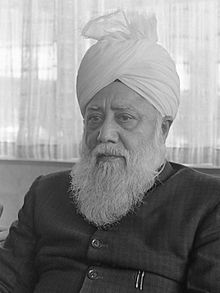Mirza Nasir Ahmad
| Mirza Nasir Ahmad | |||||
|---|---|---|---|---|---|
| Caliph of the Messiah Amir al-Mu'minin |
|||||

Khaifatul Masih III in 1967
|
|||||
| Reign | 8 November 1965 – 9 June 1982 | ||||
| Predecessor | Mirza Basheer-ud-Din Mahmood Ahmad | ||||
| Successor | Mirza Tahir Ahmad | ||||
| Born |
16 November 1909 Qadian, Punjab, British India |
||||
| Died | 9 June 1982 (aged 72) Islamabad, Pakistan. |
||||
| Burial | Bahishti Maqbara Rabwah, Pakistan |
||||
| Spouses |
|
||||
| Issue | 5 children | ||||
|
|||||
| Father | Mirza Basheer-ud-Din Mahmood Ahmad | ||||
| Mother | Mahmooda Begum | ||||
| Full name | |
|---|---|
| Mirza Nasir Ahmad مرزا ناصر احمد |
Hāfiz Mirza Nasir Ahmad (Urdu: مرزا ناصر احمد) (16 November 1909 – 9 June 1982) was Khalifatul Masih III (Arabic: خليفة المسيح الثالث, khalīfatul masīh al-Thālith), head of the Ahmadiyya Muslim Community. He was elected as the third successor of Mirza Ghulam Ahmad on 8 November 1965, the day after the death of his predecessor and father, Mirza Basheer-ud-Din Mahmood Ahmad.
Under his leadership, there was further expansion of missionary work started by his predecessor the second caliph, particularly in Africa. He also represented the Ahmadiyya Muslim Community in the National Assembly of Pakistan in 1974. Despite his efforts, the National Assembly of Pakistan declared Ahmadis to be non-Muslims and he is seen as having shown great leadership and guidance to the community during this period. the Nusrat Jehan Scheme, a scheme dedicated to serving parts of Africa by running numerous medical clinics and schools was one of the many outcomes of his 1970 tour of West Africa, regarded as the first ever visit to the continent made by an Ahmadi caliph. In 1980, Nasir Ahmad traveled to Spain, where he laid the foundation stone of the Basharat Mosque in Pedro Abad. The mosque was inaugurated posthumously in 1982 and was the first mosque to be built in Spain since the Reconquista and the Fall of Granada in 1492.
...
Wikipedia
